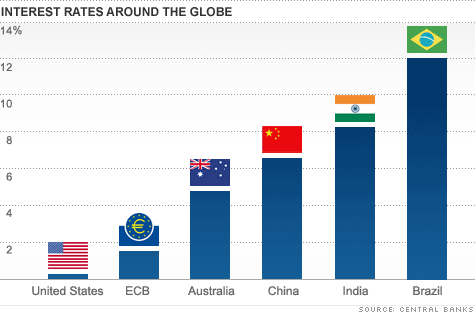Search News

Interest rates in the United States are near zero and the Fed has pledged to keep them there for a while. Other central banks, however, may have room to cut their rates.
NEW YORK (CNNMoney) -- People like to use the metaphor "pushing on a string" to describe something that's ineffective. After all, you can pull a string. But you can't really push one.
That brings us to Ben Bernanke and the rest of the Federal Reserve. If you type the search term "Fed pushing on a string" into Google, you get about 7.3 million results.

Based on that, it seems safe to say that most economists and market experts believe that even with a new version of a so-called Operation Twist to try and push down long-tem rates, there's little more the Fed can attempt to get the flaccid economy back on track.
But the Fed isn't the only central bank on planet Earth. In fact, other countries have interest rates that are substantially higher than the 0 to 0.25% range that the U.S. has been stuck in since December 2008 -- and which the Fed has said is likely to persist until at least the middle of 2013.
There are growing calls for some of those other central banks to try and help the Fed out. It shouldn't have to be the stimulator of last resort. A global coordinated easing effort could be just what the economy needs.
Anthony Sanders, senior scholar with the Mercatus Center at George Mason University in Fairfax, Va., said that the Fed should do nothing for the next few months and let other central banks that have more wiggle room begin to lower rates. If that happens, that could help lift the dollar versus other stronger currencies.
"The U.S. is at a competitive disadvantage since rates are higher nearly everywhere else," he said.
Along those lines, economists at Barclays Capital in London suggested that the European Central Bank could cut interest rates from 1.5% to 1.25% at its next meeting on October 8.
That would be a stunning turn of events since the ECB, unlike the Fed, only has one mandate: Inflation. The Fed is charged with keeping prices stable and unemployment low.
The ECB actually raised rates as recently as July. It is unclear if the ECB is willing to lower them again just because of that little sovereign debt crisis in Greece that threatens to drag down Italy and Spain and the French banking sector. Minor details.
However, the Barclays economists believe that the ECB may finally need to recognize the need for lower rates -- especially since the Fed appears to be on hold indefinitely.
What's more, with financial leaders getting together in Washington this weekend for a meeting of the World Bank and International Monetary Fund, there could be even more of a clamor for the ECB to take swifter action.
"It is clear that international pressure on the EU authorities to provide greater aggregate support is likely to be intense," the Barclays economists wrote. "The ECB might well expect to come under further pressure at the forthcoming IMF and G7 meetings, particularly if the Fed undertakes some further easing steps."
Other healthier nations may also need to consider some rate cuts as well. Australia, for example, has hiked rates seven times since 2009. Rates are now at 4.75%.
But analysts at Brockhouse Cooper, a brokerage firm in Montreal, pointed out in a report Wednesday that Australia, like many other nations, is starting to feel the pinch from a decline in commodity prices and weakening industrial production.
"We wonder how long Australia can keep raising interest rates while the rest of the developed world is lowering them," wrote the Brockhouse Cooper analysts.
Then there's the developing or emerging world. And that's where things get tricky. Brazil, China and India have rates that are much higher than the rest of the world due to legitimate inflation fears. It's unclear if these countries would join a global effort to lower rates.
Late last month, Brazil surprisingly cut rates by half a percentage point. Brazil's central bank cited the "substantial deterioration" and "significant reduction" in the global economic outlook for the move.
Still, even with that cut, rates are an astonishing 12%. And the decision to lower rates was not unanimous, with two of the seven members of Brazil's central bank voting to keep rates unchanged.
A fund manager in South America thinks that Brazil and other Latin American central banks will wind up acting more aggressively in the not-so-distant future.
"Because of the grim global outlook, I do expect Brazil and other central banks, such as Chile, to lower rates." said Heiner Skaliks, manager of the Strategic Latin America Fund (SLATX) in La Paz, Bolivia. "The Fed may be out of ammunition but South American central banks have room to cut."
Still, other central banks in emerging markets have been resistant to cut rates. There is no indication China intends to ease yet. And India's central bank actually raised rates last week by a quarter of a point to 8.25%.
India's bank acknowledged that "the global macroeconomic outlook has worsened" and that "sluggishness will persist longer than earlier expected." But the bank also stated that because of price pressures in India, it is "imperative to persevere with the current anti-inflationary stance."
One fund manager said that's the right thing to do, even it if risks being perceived as isolationist.
"Foreign central banks have to look internally at their own economic outlook when setting rates," said Randy Bateman, manager of the Huntington Situs Fund (HSUTX) in Columbus, Ohio. "Why should America dictate the world's monetary policy?"
The opinions expressed in this commentary are solely those of Paul R. La Monica. Other than Time Warner, the parent of CNNMoney, and Abbott Laboratories, La Monica does not own positions in any individual stocks. ![]()
| Overnight Avg Rate | Latest | Change | Last Week |
|---|---|---|---|
| 30 yr fixed | 3.80% | 3.88% | |
| 15 yr fixed | 3.20% | 3.23% | |
| 5/1 ARM | 3.84% | 3.88% | |
| 30 yr refi | 3.82% | 3.93% | |
| 15 yr refi | 3.20% | 3.23% |
Today's featured rates:
| Latest Report | Next Update |
|---|---|
| Home prices | Aug 28 |
| Consumer confidence | Aug 28 |
| GDP | Aug 29 |
| Manufacturing (ISM) | Sept 4 |
| Jobs | Sept 7 |
| Inflation (CPI) | Sept 14 |
| Retail sales | Sept 14 |